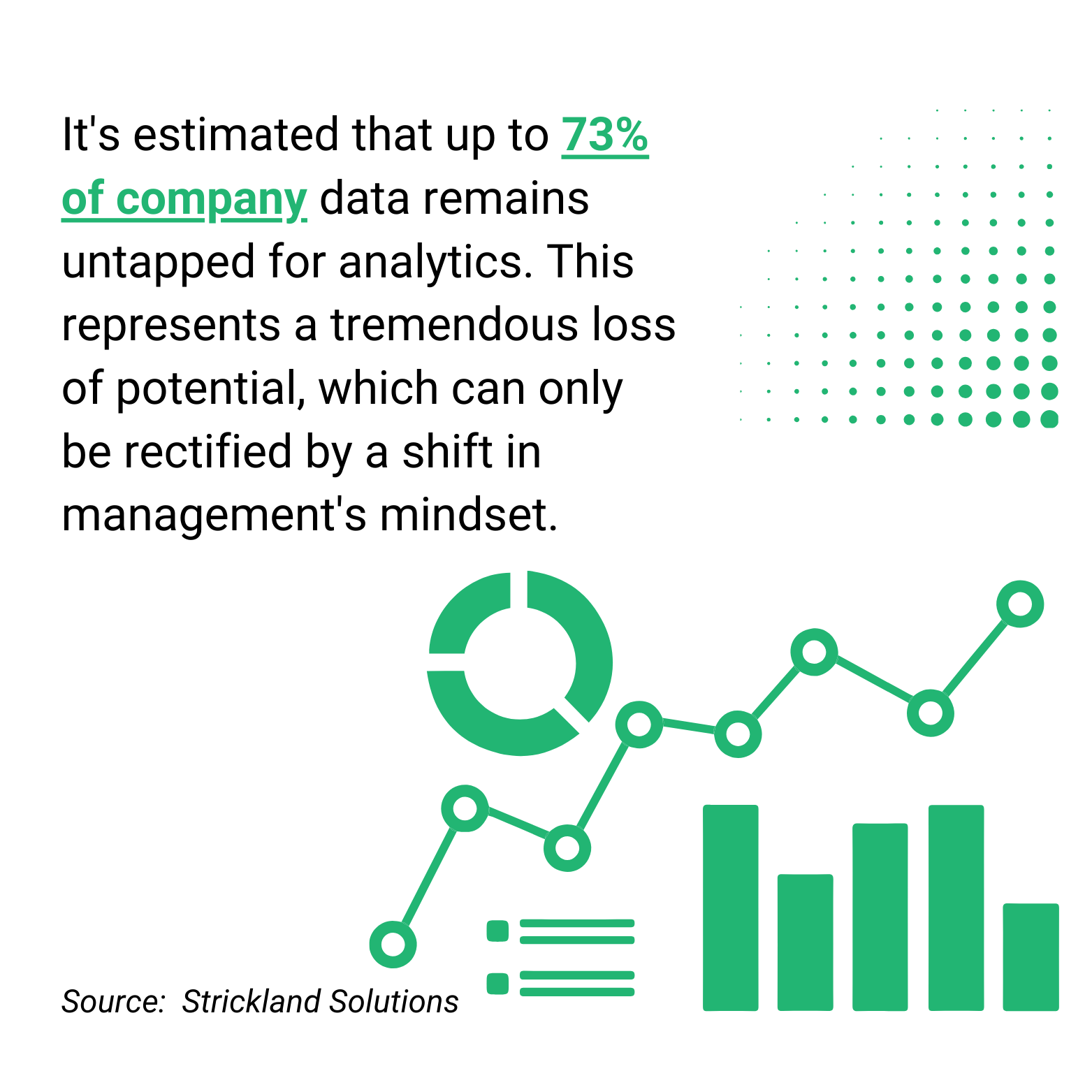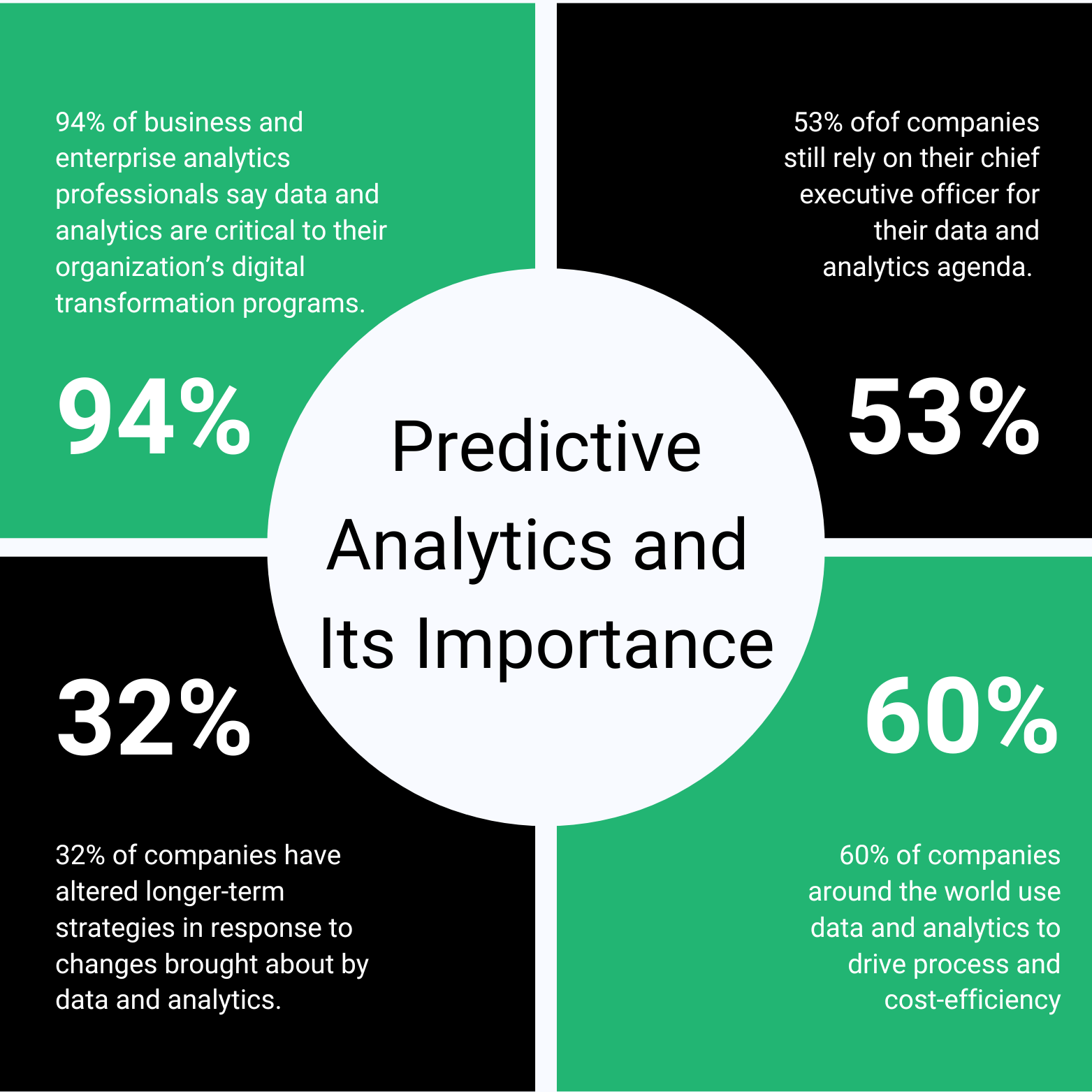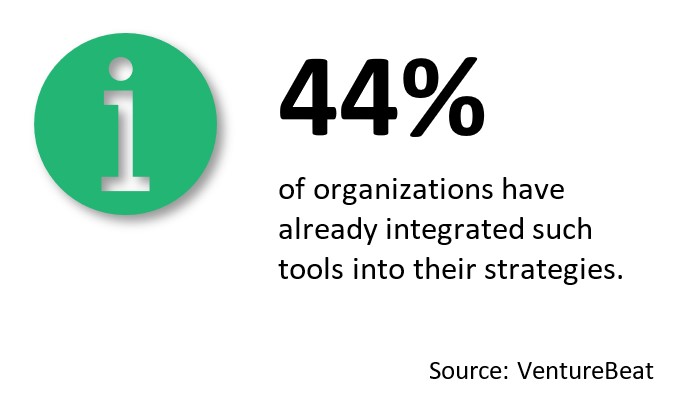
In today’s dynamic business, merely reacting to every new development and unexpected challenge isn't sufficient. Organizations must adopt a forward-looking approach: predicting results, seizing opportunities, and averting losses. How can your business stay ahead of the curve? Thanks to the surge in data availability and user-friendly software, predictive analytics is now within reach for many, empowering businesses to become more proactive and boost their profitability.
Per MicroStrategy, 94% of organizations consider analytics a critical success component for their digitalization project efforts. Today, more organizations are turning to predictive data analytics to enhance their bottom line and gain a competitive edge. But why now?
The reasons are clear:
- The explosion of diverse data types and the growing interest in extracting valuable insights from them.
- The availability of more user-friendly software.
- Stricter economic conditions demand sharper competitive differentiation.
With the rise of interactive and intuitive solutions, predictive analytics is no longer confined to mathematicians and statisticians. Business analysts and line-of-business experts are now harnessing these powerful technologies as well. Are you ready to join them? This article delves into predictive analytics, exploring its diverse advantages and modern technology solutions like AI-powered project management solutions.
Realizing the Power of Predictive Analytics
Predictive analytics is a transformative tool that can propel your business to new heights. If your company is into delivering project-based services, exceeding client and stakeholder expectations is no easy feat. Your project managers face the critical task of staying on schedule and within budget. However, every project or business initiative frequently shifts direction midway, and unforeseen obstacles can go unnoticed without accurate project forecasting. Traditional project decision-making has its merits, but having the capability to foresee your projects’ or business initiatives’ future, anticipate trends, and optimize business strategies with data-backed insights is far more result-oriented. This is where predictive analytics shines brilliantly. It fosters a culture of informed project decision-making that influences every facet of your organization.
Beyond ROI: Multifaceted Benefits of Analytics
Certainly, the technology can enhance business ROI, but its benefits extend much further. Let's explore how embracing predictive analytics software can reform your organization:
1. Enhanced Decision-Making
Imagine a scenario where various historical data points fortify your business decisions. AI-powered predictive analytics empowers you with a comprehensive project portfolio view, enabling you to make informed choices that align with your strategic objectives. MicroStrategy confirms that 57% of organizations use analytics to drive strategy and change.
2. Optimized Inventory ManagementThe delicate balance of projects’ inventory management can make or break a business. AI-assisted tools can utilize historical data, recurrent trends, and external factors to provide unparalleled insights into your projects’ inventory fluctuations. The result? Reduced project delivery costs, minimized waste, and efficient asset management.
3. Customer-Centric Strategies
What if you could identify customer preferences before they even articulated them? Predictive analytics employs various statistical techniques, machine learning, and data mining to predict future events based on historical project data that often remains elusive to human evaluation. This means you can decipher purchasing patterns, predict customer attrition and stakeholder expectations, and identify market trends well before they emerge.
According to the MicroStrategy report, companies using analytics are also experiencing better project efficiency and productivity, improved financial performance, and creating more revenue streams by choosing relevant projects, as shown in the figure titled ‘Top Benefits Companies Get Using Analytics.’
Who Uses Predictive Analytics?
Predictive analytics transforms various industries by reducing risks, optimizing operations, and boosting revenue. Here are a few examples:
 Banking & Financial Services
Banking & Financial Services
In the financial sector, predictive analytics helps detect and prevent fraud, assess credit risk, enhance cross-selling and up-selling, and retain valuable customers. For instance, Commonwealth Bank uses analytics to predict fraud within 40 milliseconds of a transaction's initiation.
Retail
Retailers leverage predictive analytics for merchandise planning, price optimization, and analyzing promotional effectiveness. A notable example is Staples, which achieved a 137% ROI by gaining insights into customer behavior through analytics.
Oil, Gas & Utilities
The energy industry uses predictive analytics to forecast equipment failures and future resource needs and mitigate safety and reliability risks. Salt River Project, Arizona's public power utility and water supplier, analyzes machine sensor data to predict maintenance needs for power-generating turbines.
 Governments & the Public Sector
Governments & the Public Sector
Governments have long utilized data analysis to understand population trends and improve services. Predictive analytics now aid in service enhancement, fraud detection, and cybersecurity. The US Census Bureau, for example, uses data analysis to study population trends.
Health Care
Predictive analytics in healthcare identifies patients at risk of chronic diseases and determines effective interventions. Express Scripts, a leading pharmacy benefits company, uses analytics to identify non-adherent patients, saving between $1,500 and $9,000 per patient.
Manufacturing
Manufacturers use predictive analytics to improve quality, prevent production failures, and optimize parts, service resources, and distribution. Lenovo, for example, reduced warranty costs by 10 to 15 percent by better understanding warranty claims through predictive analytics.
These examples illustrate predictive analytics' diverse applications beyond IT projects and significant benefits across various industries.
Modern Solutions: Where AI Meets Predictive Analytics
As technology continues its relentless march forward, the blend of AI and analytics introduces a new era of project delivery possibilities for businesses. The use of modern analytics tools is not exclusive to data teams anymore. They are intuitive and accessible to project stakeholders across your organization. These tools amplify the benefits of prescriptive analytics and reshape your organization’s functions:
1. Streamlined Project Delivery
Analytics, coupled with AI, offers project leaders a dynamic toolbox. It can foresee potential delivery bottlenecks, anticipate delays, and recommend corrective actions in real time. This synergy ensures smoother project delivery and heightened client satisfaction.
2. Efficient Resource Allocation
Project resource allocation is a critical juggling act for any business. AI-driven predictive analytics analyzes past data and ongoing trends to recommend optimal project resource allocation strategies. This enhances your projects’ efficiency and ensures resource optimization in alignment with your projects’ requirements. MicroStrategy further indicates that 60% of companies apply analytics to improve business and project processes and cost efficiency.

3. The Imperative Shift: Encouraging Data-Based Decision-Making
The ability to distill meaningful project insights becomes paramount in a world inundated with data. While the benefits of predictive analytics and AI-assisted tools are evident, their efficacy is maximized when you embrace them as part of a broader shift toward data-driven project decision-making. Here's why:
4. Embracing the Data Culture
Data-supported project decision-making is an evolutionary leap. As AI-assisted analytics tools become more intuitive, your organization must nurture a culture that encourages data exploration at every level of project delivery. This transition empowers your project stakeholders to refine their strategies with tangible project benefit realization insights, fostering innovation and adaptability.
Future-Gazing with Analytics
The future predicts an intriguing promise: analytics shaping the core of business strategies. As leaders grapple with project decision dilemmas, the path ahead is clear. Businesses that seamlessly integrate prediction analysis into their project delivery fabric will not only thrive but also pioneer transformative industry shifts.
Embrace the Inevitable
The journey toward a data-motivated future may seem daunting for now, but the rewards are boundless. The convergence of AI-powered and predictive analytics solutions ushers in a new era of project delivery precision, efficiency, and innovation. One such solution is TrueProject. TrueProject, a KPI-based predictive project management SaaS solution that improves project health and performance, empowers you to expedite project timelines by offering early stakeholder insights into potential project delivery risks through assessments and surveys. The solution uses advanced warning, predictive intelligence, and AI to identify potential project issues before they become critical. In addition, TrueProject acts as a strategic early warning system to help you enable streamlined processes. Once you start exploring the analytics landscape, the solution helps you sculpt an organization that thrives on foresight, adapts with agility, and pioneers with conviction.
As your businesses traverse complex project decision-making, the choice is clear: adopt the predictive analytics definition not as a standalone strategy but as the cornerstone of overall data-driven business growth. Get ready to make informed delivery decisions with unparalleled precision and agility, transform how your projects are managed, and enhance overall organizational success.
More information on TrueProject can be found at: TrueProjectInsight.com.

About the Author:
Brian Eckert is the Director of Engineering for TrueProject. Brian has 30+ years of experience in software development and process. He specializes in Requirements Analysis, Software Project Management, and SDLC.
Endnotes
- Farmer, Donald. “Benefits of predictive analytics for businesses.” TechTarget, December 17, 2021. https://www.techtarget.com/searchbusinessanalytics/tip/Benefits-of-predictive-analytics-for-businesses
- Jain, Piyanka. “A Complete Guide to Using Predictive Analytics in Your Business.” Entrepreneur, January 4, 2023. https://www.entrepreneur.com/growing-a-business/how-to-use-predictive-analytics-in-your-business/440597
- VentureBeat. “Report: 84% of marketing leaders use predictive analytics, but struggle with data-driven decisions.” October 27, 2022. https://venturebeat.com/ai/report-84-of-marketing-leaders-use-predictive-analytics-but-struggle-with-data-driven-decisions/
- Anthony, James. “70 Relevant Analytics Statistics: 2023 Market Share Analysis & Data.” June 16, 2023. https://financesonline.com/relevant-analytics-statistics/
- “Predictive analysis for project management.” Strickland Solutions. (n.d.). https://stricklandsolutions.com/blog/predictive-analysis-for-project-management/
- “Predictive Analytics: What is it and why it matters.” SAS Institute Inc. (n.d.). https://www.sas.com/en_in/insights/analytics/predictive-analytics.html#:~:text=Predictive%20analytics%20is%20the%20use,will%20happen%20in%20the%20future.





